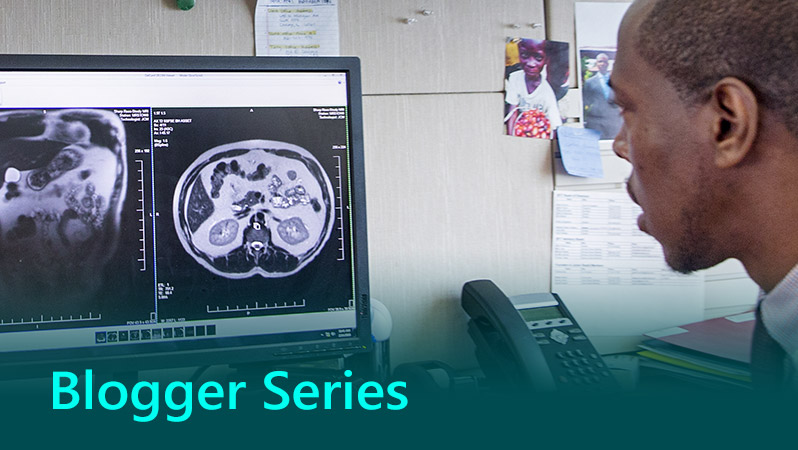
DrDoctor prescribes automation for healthcare

 We’re going to be sharing a story every week for the 12 weeks of summer, showing you how healthcare organisations are using technology to transform patient outcomes and increase productivity. For the second blog in the series, Phil Allen, Technology Strategist for Healthcare and Life Sciences at Microsoft, will be sharing an example of how cloud computing and automation can help deliver high-quality, patient-centric care.
We’re going to be sharing a story every week for the 12 weeks of summer, showing you how healthcare organisations are using technology to transform patient outcomes and increase productivity. For the second blog in the series, Phil Allen, Technology Strategist for Healthcare and Life Sciences at Microsoft, will be sharing an example of how cloud computing and automation can help deliver high-quality, patient-centric care.
I’m always excited to discover how people are harnessing Microsoft Azure in a healthcare setting. DrDoctor, which delivers patient-facing automated technology, is one such example.
The company is working with NHS Wales and hospitals including Nottingham University Hospital to digitally transform the health service. This is achieved by automating key procedures and letting patients take greater control over their own care. Success comes by embracing both public cloud and open standards to make interoperable, future-proof solutions that are scalable and secure.
Within 20 years, the company hopes to see a new type of hospital; hospitals that work in radically different ways, removing time-consuming paperwork and using digital tools for better patient-clinician interaction and managing clinical risk.
One of DrDoctor’s core beliefs is in changing systems from the inside out. This isn’t a quick fix, then, but a cultural shift. One that creates a secure healthcare infrastructure that works for both patients and practitioners by adapting current processes and adding incremental value. Putting cutting-edge technology into the hands of providers delivers the first tremors of a fundamental shift in the quality and cost of delivering long-term, high-quality, patient-centric care.
Moving to cloud computing
Since NHS Digital released their guidance for NHS organisations adopting public cloud, Microsoft Azure has become the go-to cloud computing platform for DrDoctor. In a recent interview, Tom Whicher, DrDoctor’s co-founder, told Health Tech Newspaper that the business pursued this strategy because it “allows us to leverage [Microsoft’s] machine learning technology, scale much more quickly and to reach more patients. We want to make sure we’re always using, developing on and giving patients the latest and best in high tech.”
Warming to his subject, Whicher added that, “the biggest technology challenge for the NHS is beginning to implement a new set of standards. Going forward, all of our interfacing will be [Fast Healthcare Interoperability Resources] FHIR compliant. In order for the NHS to achieve its ambitions, it needs to adopt FHIR, two-way integration, and open standards at scale. That means getting lots of legacy systems to integrate with newer tech and solving lots of those dreary back-office problems.”
Helping overcome that challenge is Microsoft’s Azure API for FHIR, a fully-managed, standards-based and compliant healthcare data platform. It’s not by accident that the cloud computing platform is capable of powering Internet of Medical Things (IoMT) scenarios, population health research projects, AI-powered diagnostic solutions and more. With security and privacy fully embedded into the service, conforming to global health privacy and security standards, users have full control over how patient data is used and stored.
Clinical analytics can be pulled together from multiple records systems, then normalised using common models and specifications. Leveraging such data in AI workloads means users gain the insights needed to power new systems of engagement. This includes clinician and patient dashboards, diagnostic assistants, population health insights, and connected healthcare scenarios, such as Remote Patient Monitoring.
All of which lets healthcare organisations bring clinical health data into the cloud based on the interoperable data standard FHIR. It’s what allows professionals to more easily respond to changing business dynamics.
Creating change in healthcare
DrDoctor was determined to push ahead with FHIR as the standard for interoperability in UK healthcare. Microsoft have developed an open-source FHIR server that uses Azure services to deliver a fully operational API. This is backed by a data repository, offering an enormous head-start for those moving across to FHIR.
Alberto Amati, Senior Developer at DrDoctor and self-proclaimed ‘cloud expert’, explained in his blog how this has been enabled over the data-based Health and Social Care Network (HSCN). By deploying an Azure Application Gateway in a new subnet in the HSCN VNet, and only configuring it with a private IP address, the business could use it to control access to the FHIR App Service. The team used VNet Service Endpoint combined with a new VNet Integration. This ensured the Microsoft Azure Cosmos DB could only be accessed by DrDoctor’s own FHIR service.
Despite recent business innovations, it’s Whicher’s belief that, “we need to ensure that we bring our hospital partners with us on this journey. It isn’t easy creating change in healthcare… We need to make sure we stay on top of the latest technologies which is why we’ve invested in moving all of our product to Microsoft Azure.”
By leveraging the Azure Cloud and Microsoft’s FHIR API and Server, automated technologies, like the DrDoctor platform, create an environment where hospital teams can, in Whicher’s words, “refocus their time and focus on all the value-adding work for patients.”
Find out more
Discover how virtual consultations are improving patient care
About the author

Phil Allen is a Technology Strategist for Healthcare and Life Sciences at Microsoft. Passionate about the potential of technology to transform health and healthcare, he has 20 years’ experience at Microsoft helping customers and partners chart a course to the future with technology and get the best out of their investment.




